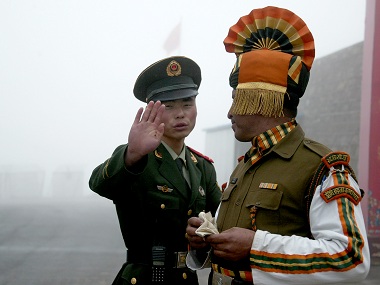A statement released by India’s Ministry of External Affairs has triggered feverish speculation that the two-month long faceoff between India and China is nearing an end in the tri-junction area in Doka La, a barren patch of land more than 14,000 feet above sea-level. Since 16 June, when Indian troops with bulldozers in tow moved into the strategic location to physically stop a PLA-led road-building party from changing the status quo at an area claimed both by China and Bhutan, Asia’s largest neighbours have been locked in a calm but increasingly tense standoff. Not a day has passed during the duration of these 60 days that China, either officially or through its state-controlled media, has not threatened war against India. As strategic affairs expert Brahma Chellaney wrote in The Japan Times, the standoff showed “how China blends psychological warfare (“psywar”), media warfare and the manipulation of legal arguments (“lawfare”) to undermine the opponent’s information-control capabilities and to buttress its strategic game plan. Disinformation and deceit are among the tools China is employing in its psywar to tame India without military combat, in Sun Tzu style.” For instance, while India’s external affairs minister Sushma Swaraj announced on the floor of the Parliament that India has no wish to enter into a military conflict with China and would like to solve it diplomatically, she was answered with an impatient sneer and a slur from Beijing. Meanwhile, tiny Bhutan was sucked into the vortex of conflict between two of the most powerful nations and has tried its best to pull off a precarious balancing act. However, we must be careful about jumping to conclusions about the modalities of disengagement. The MEA statement, released at noon today from the Twitter handle of MEA spokesperson Raveesh Kumar, does not specify whether this a one-sided withdrawal on India or China’s part, or a synchronised pulling out of troops.
MEA Press Statement on Doklam Disengagement Understanding pic.twitter.com/fVo4N0eaf8
— Randhir Jaiswal (@MEAIndia) August 28, 2017
In the absence of the mechanism of withdrawal, it is impossible to speculate whether this marks as the end, or if some sort of a calibrated understanding has been reached. Crucially, Reuters India has quoted Chinese foreign ministry as saying that the troop withdrawal has been “unilateral” from India’s side.
JUST IN: China foreign ministry says Indian forces have already withdrawn to the Indian side of border pic.twitter.com/6kZSAWGqip
— Reuters Asia (@ReutersAsia) August 28, 2017
And in a later Twitter post, Reuters India indicated that Chinese troops will “continue to patrol Doklam”.
MORE: China foreign ministry says Chinese forces will continue to patrol in Doklam region pic.twitter.com/gFylVqfRxV
— Reuters Asia (@ReutersAsia) August 28, 2017
Meanwhile, Chinese news outlets started tweeting that India had “unconditionally withdrawn its troops”.
India, following its intrusion into China’s Donglang area, removed all its personnel and facilities back to its side of China-India border. pic.twitter.com/aLeMuX6RUU
— China Daily (@ChinaDaily) August 28, 2017
Most importantly, however, in claiming that its troops will “continue to patrol in Doklam”, China has not mentioned whether its road-building exercise — which was the bone of contention — will resume. That China will “patrol Doklam” is nothing new, and PLA has been touring the strategic location for decades. This has resulted in 24 rounds of talks so far between China and Bhutan so far. The issue still remains unresolved. So while the Chinese side will “continue to patrol in Doklam”, they may refrain from activities such as motorable road-building. This at least seems to be the formula of extrication.
#BREAKING: Sources tell Republic that Chinese have agreed not to build the road #DoklamStandoffEnds https://t.co/lpnVZxoMbs
— Republic (@republic) August 28, 2017
Impact Shorts
More ShortsWhat emerges from this stage-managed media tango is that both China and India are actively engaged in disengaging from Doka La ahead of the BRICS Summit, because none of the sides want the conflict to overshadow the summit. Obviously, both countries would have worked out a face-saver, and that is exactly what we are witnessing right now. If indeed this is the end of the standoff, this will qualify as a win for India which had placed its faith all along in quiet diplomacy. But that call should wait for now.


)




